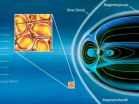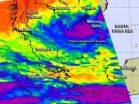(Press-News.org) VIDEO:
This is a computer simulation of one octant of a core collapse supernova, using SNSPH.
Click here for more information.
Two University of Texas at Arlington researchers want to bridge the gap between what is known about exploding stars and the remnants left behind thousands of years later. So they're trying something new – using SNSPH, a complex computer code developed at Los Alamos National Laboratory.
On Tuesday, Carola I. Ellinger, a post-doctoral researcher at UT Arlington, and Sangwook Park, an assistant professor in the College of Science's physics department, were scheduled to present their research on "3D Simulations of Supernovae into the Young Remnant Phase" at the national meeting of the American Astronomical Society in Long Beach, Calif. Their oral presentation focuses on first efforts to use SNSPH, a parallel 3-dimensional radiation hydrodynamics code written in 2005, to create 3D simulations of a core-collapse supernova evolving into remnants.
"There are a lot of numerical simulations for the explosion of the supernova and a lot of simulations of the blast wave expanding into interstellar medium, but there was no useful work connecting the two, even though the physics are connected," said Park. "Now, we are using the most appropriate program we know to do that."
Besides Ellinger and Park, co-authors of the abstract include: Gabriel Rockefeller and Chris Fryer, of the Computer, Computational, and Statistical Sciences division at Los Alamos National Laboratory; and Patrick Young, of the Arizona State University School of Earth and Space Exploration.
Core collapse supernovas make up nearly three-quarters of all supernovas and they are the type of star explosions that create black holes and neutron stars. Scientists study them to learn more about the history and landscape of the universe, including how minerals were distributed and planets formed. Typically, individual researchers focus on either the blast or the remnants.
Though their project is in its initial stages, the researchers hope their new models will help reveal the detailed nature of the two features of a supernova remnant - characteristics that arose in instabilities during the explosion and those that were created in the interaction with surrounding medium. Ellinger said she hopes the simulations will eventually be used to interpret X-ray data from NASA's Chandra space telescope as well as other missions, such as the Nuclear Spectroscopic Telescope Array, or NuSTAR, launched in 2012.
"Dr. Park and Dr. Ellinger are taking existing tools, looking at the rapidly expanding field of astronomy data and finding new ways to use the two together. This kind of creative thinking is a model for UT Arlington students and fellow scientists," said Pamela Jansma, dean of the UT Arlington College of Science.
The research team used resources at the Texas Advanced Computing Center at UT Austin for hydrodynamic calculations.
Park said the new work with SNSPH can be traced back to increases in data about the composition of supernova remnants, much of which has been brought about by the Chandra X-ray Observatory. Chandra, launched in 1999, is NASA's flagship mission for X-ray astronomy.
With increasingly detailed data, scientists studying supernova remnants in the Milky Way are now able to differentiate between debris that was ejected from the exploded star, also called the progenitor, and the pre-existing ambient material that was swept up in the blast wave. This gives researchers some of the parameters they need to trace the history of the remnant, according to Park and Ellinger.
INFORMATION:
The UT Arlington team's work on supernovas is supported by Chandra grants from the Smithsonian Astrophysical Society.
Park and Ellinger are two of the innovative researchers at The University of Texas at Arlington, a comprehensive research institution of more than 33,200 students and more than 2,200 faculty members in the heart of North Texas. Visit www.uta.edu to learn more.
END
By taking a "bottom-up" approach, researchers at the University of Illinois at Urbana-Champaign have observed for the first time that "size does matter" in regards "pyroelectricity"—the current/voltage developed in response to temperature fluctuations that enables technologies such as infrared sensors, night-vision, and energy conversion units, to name a few.
"Controlling and manipulating heat for applications such as waste heat energy harvesting, integrated cooling technologies, electron emission, and related functions is an exciting field of study today," explained ...
HERSHEY, Pa. -- While the number of overweight and obese Americans has increased, the amount of weight counseling offered by primary care physicians has decreased -- especially for patients with high blood pressure and diabetes -- according to Penn State College of Medicine researchers.
More than 145 million adult Americans are overweight or obese.
Researchers analyzed data from the National Ambulatory Medical Care Survey for the years 1995-1996 and 2007-2008. This national survey collects information about the provision and use of outpatient medical care services in ...
Our Milky Way is a spiral galaxy - a pinwheel-shaped collection of stars, gas and dust. It has a central bar and two major spiral arms that wrap around its disk. Since we view the Milky Way from the inside, its exact structure is difficult to determine.
Astronomers have identified a new structure in the Milky Way: a long tendril of dust and gas that they are calling a "bone."
"This is the first time we've seen such a delicate piece of the galactic skeleton," says lead author Alyssa Goodman of the Harvard-Smithsonian Center for Astrophysics (CfA). Goodman presented the ...
ROCHESTER, Minn. -- A combination of the drugs pazopanib and paclitaxel shows promise in slowing anaplastic thyroid cancer (ATC), according to a Mayo Clinic-led study published in the journal Science Translational Medicine. The two drugs together resulted in greater anti-cancer activity in ATC than either drug alone, says lead researcher Keith Bible, M.D., Ph.D., a Mayo Clinic oncologist.
Anaplastic thyroid cancer is a rare but devastating form of thyroid cancer that typically strikes men and women in their 60s and 70s. It is very aggressive, with a median survival ...
The sun ejects a continuous flow of electrically charged particles and magnetic fields in the form of the solar wind -- and this wind is hotter than it should be. A new study of data obtained by European Space Agency's Cluster spacecraft may help explain the mystery.
The solar wind is made of an electrically-charged gas called plasma. One theory about the wind's puzzling high temperatures is that irregularities in the flow of charged particles and magnetic fields in the plasma create turbulence, which, in turn, dissipates and adds heat to its surroundings. Using two separate ...
The eighth tropical cyclone to form during the Southern Indian Ocean cyclone season formed from low pressure System 98S and became Tropical Cyclone Narelle. NASA's TRMM satellite passed over System 98S and saw the hallmark "hot towers" that indicated the storm would soon likely intensify into Tropical Storm Narelle.
NASA's Tropical Rainfall Measuring Mission (TRMM) satellite passed over System 98S on Jan. 7 at 0901 UTC (4:01 a.m. EST/U.S.) hours before it intensified into Tropical Storm Narelle.
TRMM's Precipitation Radar instrument captured estimates of rainfall occurring ...
Tropical Depression Sonamu has been consistently slow moving over the last couple of days, and that has not changed. NASA's Aqua satellite captured an infrared image of the stubborn storm lingering in the South China Sea, and it still contained some strong thunderstorms.
When NASA's Aqua satellite passed over Tropical Depression Sonamu on Jan. 8 at 0641 UTC (1:41 a.m. EST/U.S.), the Atmospheric Infrared Sounder (AIRS) instrument aboard took an infrared look at the storm. AIRS data showed that Sonamu still contained some very cold cloud top temperatures of -63F (-52C) ...
Older adults who have suffered from aphasia for a long time can nevertheless improve their language function and maintain these improvements in the long term, according to a study by Dr. Ana Inés Ansaldo, PhD, a researcher at the Research Centre of the Institut universitaire de gériatrie de Montréal (University Geriatrics Institute of Montreal) and a professor in the School of Speech-Language Pathology and Audiology at the Faculty of Medicine of Université de Montréal. The study was published in Brain and Language.
After six weeks of intensive and specific language therapy, ...
Marine biologists are beginning to understand the varied diving and foraging strategies of filter-feeding whales by analyzing data from multisensor tags attached to the animals with suction cups. Such tags, in combination with other techniques such as echolocation, are providing a wealth of fine detail about how the world's largest creatures find and trap their prey.
Recent studies on the behavior of baleen whales—which filter small fish or invertebrate animals from seawater—are described in the February issue of BioScience. Jeremy A. Goldbogen of the Cascadia Research ...
New York (January 9, 2013) -- A new study by NYU School of Medicine researchers reveals that an especially virulent strain of the gut bacterium Helicobacter pylori (H. pylori) isn't implicated in the overall death rate of the U.S. population, and may even protect against stroke and some cancers. The findings, based a nationwide health survey of nearly 10,000 individuals over a period of some 12 years, are published online, January 9, in the journal Gut.
Those individuals carrying the most virulent strain of H. pylori, the study found, had a 55 percent reduced risk of ...



